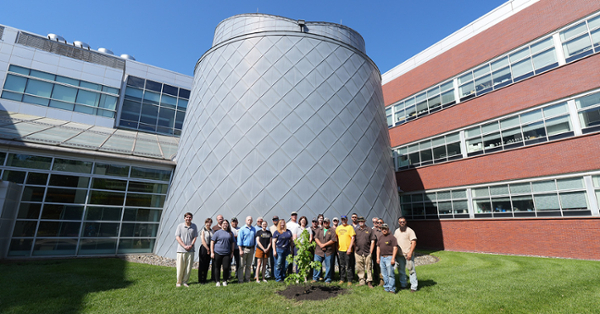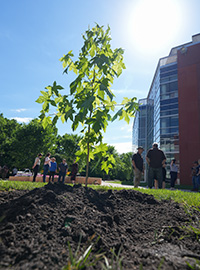Rowan named custodian for an Artemis Moon Tree
Rowan named custodian for an Artemis Moon Tree

Unlike any other tree at Rowan University, a particular sweetgum sapling planted this summer has a name. And it’s an appropriate moniker for the little ambassador now standing outside the Ric & Jean Edelman Planetarium.
Germinated from a seed flown on a 2022 NASA mission around the moon, the tree was sent to Rowan this year as part of the federal agency’s Artemis Moon Tree project through its Office of STEM Engagement’s Next Gen STEM project and the U.S. Department of Agriculture’s Forest Service. 
The project was inspired by the first Moon Tree seeds flown aboard Apollo 14 in 1971 and then distributed to schools and public institutions throughout the United States. For this project, NASA packaged 1,000 seeds from five North American tree species for their 270,000-mile, 26-day flight aboard the Orion spacecraft, beyond the moon and back.
Back on Earth, the Forest Service germinated the seeds—which also included sycamores, Douglas firs, loblolly pines and giant sequoias—nurturing them until they were big enough to send to public and education institutions across the country. The purpose is to inspire future generations of scientists and environmentalists.
Rowan University’s College of Science & Mathematics successfully applied to serve as an Artemis Moon Tree custodian and the seedling was delivered to the Glassboro campus in May. The well-traveled tree is now part of Rowan’s newly certified arboretum.
“We’re really excited to have one of these trees,” said Amy Barraclough, director of the Edelman Planetarium.
The American sweetgum (Liquidambar styraciflua) features glossy green, star-shaped leaves and hard, spiky fruit. The tree is a host for the caterpillars of the luna moth, also known as the American moon moth.
Though safely planted, the young tree isn’t out of the woods just yet. Rowan maintenance crews kept the seedling watered through successive heat waves this summer and erected fencing to protect it from animals.
They also gave the tree a feminine name, chosen on the spot during a brief planting ceremony.
It’s “Luna,” of course.